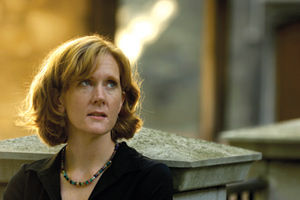|
||
      |
Beyond the Rising Sun
Hurricane Katrina prompts a Chicago archaeologist to refocus her New Orleans research.

After uncovering Native American pottery from the 1600s—and evidence
of a hotel that might have inspired a folk song—Shannon Lee Dawdy
returned to New Orleans to help salvage the city’s archaeological
sites.
Despite the pottery’s significance, another find captured the most media attention. Higher up on the dig site, Dawdy uncovered evidence of a hotel that burned down in 1822 and, according to contemporary advertisements and newspaper articles, was called the Rising Sun. In March the New Orleans Times-Picayune reported on speculation that the hotel was the House of the Rising Sun, from the old folk song made famous by the Animals in 1964. The Los Angeles Times, London Independent, and Associated Press all picked up the story.
Dawdy, who joined the U of C as an assistant professor of anthropology in July 2004, spent this past summer sifting through New Orleans archives for details on the Rising Sun hotel and her other Conti Street findings—a French colonial garden, a Spanish colonial home, a late-1820s upscale hotel, and a shirt factory and molasses plant that burned down in 1887. In the basements of the Civic Center public library and the Civil Courts building, Dawdy pored through notarial records, legal documents, and city-council minutes, many in French and Spanish, to find ordinances, regulations, and reports to help put the structures in context.
Was the Conti Street hotel the brothel that inspired the song? As the traditional lyrics go: “There is a house in New Orleans / they call the Rising Sun / It’s been the ruin of many a poor girl / and me, O God, for one.” (The Animals changed “girl” to “boy” and made other tweaks.) The evidence is intriguing, Dawdy says, but inconclusive. It’s true that the diggers collected “lots of liquor bottles, some smoking pipes, and an unusual number of faience rouge pots.” And a January 1821 ad in the Louisiana Gazette boasted that “Gentlemen” could expect “the best entertainment,” “rely upon finding attentive Servants,” and enjoy “genuine good Liquors” and food.
Yet there’s reason for doubt. Folk songs often have multiple roots; this one echoes an English ballad. The song “makes no reference to this devastating fire where two men died,” Dawdy notes, and the hotel operated for only 13 months before burning down—not much time to ruin “many a poor girl.” The Rising Sun motif, furthermore, was popular with taverns on both sides of the Atlantic. “Every port city in the English-speaking world,” she says, “has a House of the Rising Sun.” In 1808 a ship by that name docked in New Orleans, and a Rising Sun coffee house operated on Decatur Street in 1838.
So while “it’s possible there was a brothel in New Orleans called Rising Sun that maybe gave rise to this version of the song,” she says, “I think it’s an incredible coincidence.” The Conti Street hotel, she explains, may not have been a brothel. The women who worked there may have been dancers, or there “could have been another arrangement for commercial sex.”
Although the media jumped on the Rising Sun hotel/song possibility, after Hurricane Katrina the debate “seems so trivial,” Dawdy says. She had done archaeological work in New Orleans on and off for 12 years and, with her jazz-musician husband, adopted it as a hometown. Now she’s reprioritized her research projects. She still plans to send her book, The Devil’s Empire: French New Orleans and the Shadows of Colonialism (University of Chicago), to press in September 2006. The Conti Street archive work and her studies on 16th-century Gulf-region smuggling, meanwhile, are on hold while she has begun other ventures.
Returning to Chicago in early August, almost three weeks before Katrina hit, Dawdy headed to Baton Rouge in late September to spend the rest of fall quarter as a liaison between FEMA and the state of Louisiana. During the cleanup and rebuilding effort, she aims to ensure that “historical resources are included in the plan.” New Orleans’s archaeological sites “have probably fared fine,” she says, because in most areas “the water moved slowly enough not to cause significant erosion of the ground surface.” In the city, she says, “it’s the demolition and rebuilding that could tear them apart.” Yet on the coasts south and east of the city, the water’s force may have “severely impacted or obliterated” dozens or even hundreds of prehistoric sites, shipwrecks, and small historic sites.
After assessing the regional damage, she hopes to at least catalog the sites—some perhaps now under water—so archaeologists can return someday. “I think I’ll be able to do research there,” she says. And the disaster has provided new archaeological questions. “I’m going to have to consider how this hurricane or past ones have moved objects around. I’ll be able to see the signature of a hurricane on an archaeological site and record it.”
She’s also reappropriated the Conti Street hotel for a new book, with architectural preservationist Andrew Ferrell, called A House in New Orleans. A trade book for the public and her colleagues, it will look at “how people emotionally relate to their houses and express themselves through them.” Each chapter will spotlight one home and an accompanying emotion, including the historically preserved houses long valued in New Orleans and homes that people wouldn’t leave during Katrina. The first chapter, Dawdy says, will feature the Rising Sun.